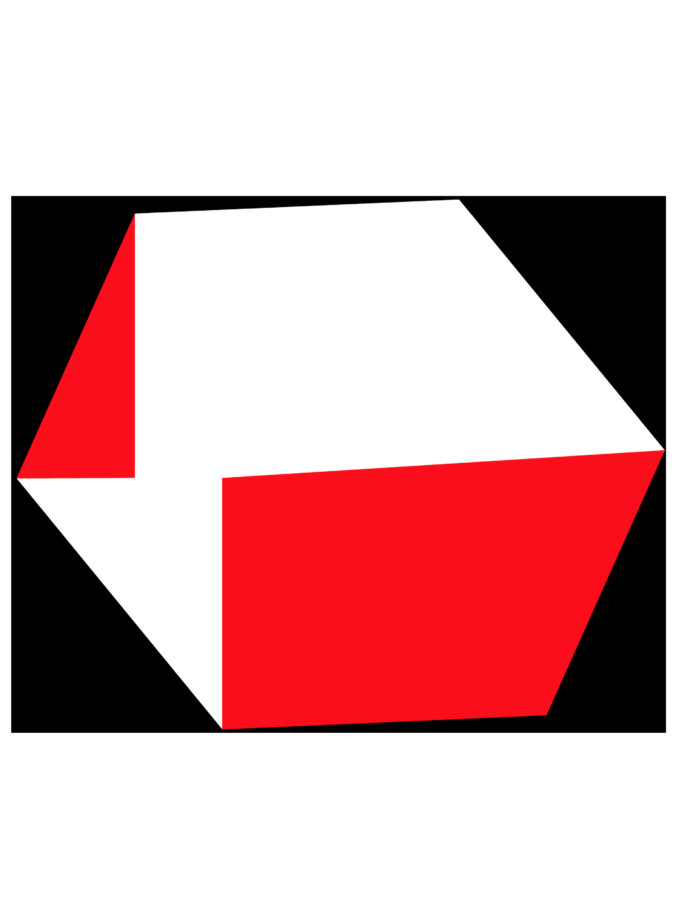Madrid exhibition
COLD AMERICA
Geometric Abstraction in Latin America
(1934-1973)
11 February to 15 May 2011
THE ARTISTS
ARGENTINA
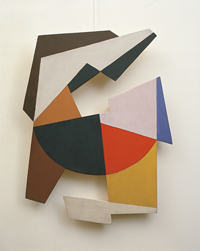
Juan Bay
Composición, 1950
óleo sobre contrachapado
Colección particularBay, Juan
Trenque Lauquen, Buenos Aires, 1892-Italia, 1978
Painter, draughtsman, and art critic
During the central years of the twentieth century, Bay’s oeuvre was influenced by futurism and subsequently by constructivist and concrete painting. Throughout this period, he produced a number of abstract wood reliefs to which he applied bright colors. In these, the interplay between curves, angles, and empty space allow the back wall to come into view. These works are not constrained by a picture frame or its customary rectangular shape; instead they generate a sense of movement that may be seen as evidence of Bay’s association with futurism.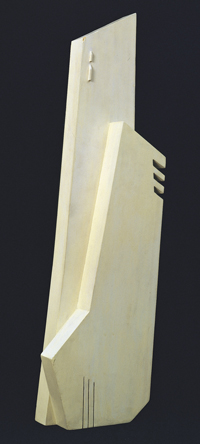
Martin Blaszko
Columna madí, 1947
Madera pintada
Malba – Fundación Costantini,
Buenos AiresBlaszko, Martin
(o Blasko or Blaszkowski) Berlín, 1920 Painter, sculptor, and draughtsman of German origin
Essentially, his oeuvre relies on the balance he achieves between opposing forces and the rhythmic interplay of conflicting formal values and coplanar elements. In line with Madí principles, he replaced geometric abstract forms for a combination of independent planes, thus overcoming the tendency to interpret any shape as a figure against a background. Among Blaszko’s sculptures for public spaces is Júbilo (Jubilation, 1991), on view at Parque Centenario in Buenos Aires.

Juan del Prete
Composición con elementos geométricos, 1949
óleo sobre cartón
Colección particularDel Prete, Juan
Vasto, Chieti, Italia 1897- Buenos Aires,1987
Painter, draughtsman, sculptor, stage designer, layout artist, and photographer of Italian origin
An unorthodox and inquisitive artist, he moved between abstract and figurative art, painting dynamic and dark contours. Giotto, Cézanne, and Matisse are among his influences, as well as cubist and futurist artists. From 1946 to 1955, loud colors and flat, geometric shapes dominated his compositions. Impressed by Art Informel, Del Prete soon added stains, drips, and blots to his works. He did, however, return to the expressive quality that is a feature of his work in a variety of media, including painting, sculpture, collage, and assemblage.
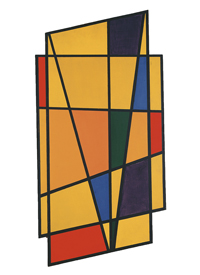
Manuel Espinosa
Pintura, 1945
óleo sobre aglomerado
Colección particularEspinosa, Manuel
Buenos Aires, 1912-2006
Painter, draughtsman, and sculptor
Espinosa was initially influenced by surrealism but soon shifted to concrete painting. In his serial compositions, geometric figures, such as the square and circle, are arranged in the foreground and repeated in sequences in the mid- and background. As a result, the spectator feels he is in a deep compressed space. Faithful to the principles of non-figurative art, Espinosa’s clear and restrained style of geometric painting relies on controlled sequences of elements. Transparent, juxtaposed, and superimposed elements give way to optic illusions.
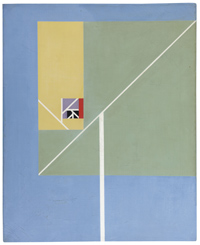
Alfredo Hlito
Derivación del cuadrado, 1954
óleo sobre lienzo
Galeria Guillermo de Osma, MadridHlito, Alfredo
Buenos Aires, 1923-1993 Argentine painter, son of Syrian immigrants
In the series Construcciones (Constructions, 1945), contrasting patterns of formal elements play out over a modulated monochrome grid. Hlito later explored the tension arising between solid color and linear color formations. He abandoned Planismo in 1954 and began painting interior spaces while experimenting with sinuous lines and contrasting light effects. By the late 1950s, his work deviated from geometric abstraction. Rather than exploring the relationship between figures and backgrounds, he chose to apply color over a distinct luminous and dynamic backdrop. In the series Espectros (Specters), Hlito applied color with small systematic strokes. In Simulacros (Drills), dating from the 1960s, shades of ocher and grey dominate the surface as sets of parallel lines generate interior spaces leading to vague focal points. In the mid-1970s, phantasmagoric and increasingly anthropomorphous structures made their way into the artist’s compositions. The simple and ascetic pieces entitled Efigies (Effigies) were inspired by art history icons, conveying a religious and mystical quality.
Enio Iommi
Continuidad interrumpida, 1948
Esmalte sobre metal, sobre base
de granito negro
Malba – Fundación Costantini,
Buenos AiresIommi, Enio
Rosario, Santa Fe, 1926
Argentine sculptor and painter, son of Italian immigrants, He lives in Buenos Aires
Using the principles of geometry and linear and directional structures, he transformed empty space into an important element in permanent connection with volume. The 1960s marked Iommi’s departure from pure concrete art and his new-found interest in open structures. The ensembles of objects, sculptural assemblages, and impoverished materials dominant in his production during the 1970s responded to his search for “spatial drama.” He incorporated household utensils to his work, cutting and combining pieces according to a poetic and sculptural narrative.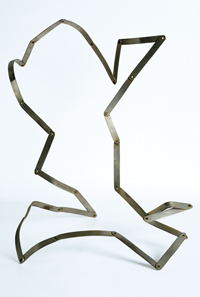
Gyula Kosice
Escultura articulada móvil, 1945
Flejes de bronce, pátina cromada
Colección particularKosice, Gyula
(Fernando Fallik)
Košice, Czechoslovakia (now Slovakia), 1924
Sculptor, painter, poet, and theorist of Slovak origin- He lives in Buenos Aires
Inspired by constructivism, Kosice created Röyi (1944), his first articulated, abstract mobile made of wood. He was a pioneer in incorporating neon to artworks, as seen in Estructuras lumínicas con gas neón (Radiant Structures with Neon Gas, 1946). With Escultura hidráulica (Hydraulic Sculpture, 1957), he introduced water as a key element, which came to be, along with Plexiglas, light, and movement, a trademark feature of his oeuvre. Kosice devised the utopian project Ciudad hidroespacial (Hydrospatial City), an idea previously suggested in Arturo magazine. In 1964, he designed the Argentina Pavilion at the Venice Biennale. In 1988, he was commissioned a sculpture for the Olympic Games in Seoul, resulting in the monument Victoria.
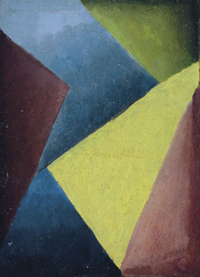
Esteban Lisa
Composición, c 1935
Anverso y reverso
óleo sobre cartón
Colección Jorge Virgili, MadridLisa, Esteban
Hinojosa de San Vicente, Toledo, 1895- Buenos Aires, 1983
Argentine painter, draughtsman, educator, and theorist of Spanish origin
His work gradually shifted to abstract art between 1925 and 1934, when he began applying rich impasto to depict landscapes and figures stripped of detail that would eventually transform into amorphous shapes. Lisa’s paintings thus moved towards geometric abstraction and began featuring different types of symbols in the 1940s. His palette grew brighter throughout the 1950s, resulting in freer, more expressive compositions. In the prolific series Juego con línea y colores (Playing with Lines and Color), spirals, swirls, curves, and arabesques make their way into his work. The brilliant colors and spontaneous brushwork moving in multiple directions allude to a cosmic world.
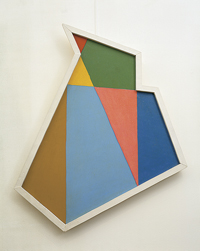
Raúl Lozza
Pintura n° 21, 1945
óleo sobre contrachapado
Colección particularLozza, Raúl
(Raúl Elbio Lozza)
Alberti, Buenos Aires, 1911 – Buenos Aires, 2008 Argentine painter, draughtsman, designer, journalist, and theorist, son of Italian immigrants
His asymmetrical compositions did not have a focal point and were instead organized around independent color fields. He sought to create an open and accessible structure capable of generating a specific shape. For Lozza, a bare surface was not a background but rather a “colored field.” He envisaged a new theory in which color, understood in terms of relative discontinuity and potentiality, replaced concepts such as “harmony” and “complementary.” As a result, form was the only valid vessel for connecting ideas. Lozza disapproved of geometry, which he thought inefficient, and only used number operations as a complementary method. His theory of “the ‘qualimetry’ of flat form” provided a mathematical formula which demonstrated that the sum of all parts is greater than the whole.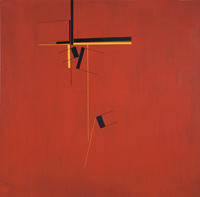
Tomás Maldonado
Tema sobre rojo, 1953
óleo sobre lienzo
Colección particularMaldonado, Tomás
Buenos Aires, 1922
Painter, graphic and industrial designer, teacher, and theorist. He lives in Milan
Maldonado completed his first concrete artworks in 1944. Influenced by Vantongerloo, he took up graphic design in the late 1940s but soon turned to industrial design, which had a great impact on his later work. Interested in creative processes, his approach to design was scientific and systematic. He believed manufactured goods had formal qualities like those “found in the structural and functional relationships that turn systems into coherent wholes.” After devoting most of his career to writing, teaching, and research, Maldonado took up painting again in 2000.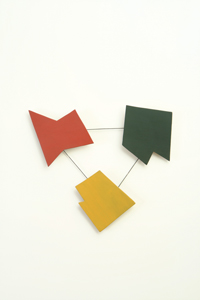
Juan Melé
Coplanar n° 18, 1947
óleo sobre lienzo
Colección Raul NaonMelé, Juan
Buenos Aires, 1923
Painter, sculptor, and art critic. He lives between Buenos Aires and Paris
Melé’s output in the 1940s drew from concrete painting, as evidenced in his trimmed picture frames and coplanar compositions. He developed these aspects throughout his career, applying them to painting, sculpture, and embossing. In the 1990s, Melé began his prolific series of Relieves (Reliefs), painting-objects featuring indented and elevated surfaces as well as trimmed edges with vibrating color combinations.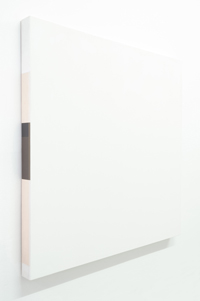
César Paternosto
The Sweetest Skin, 1970
(La piel más dulce)
Emulsión acrílica sobre lienzo
Colección de la Junta de Andalucía
– Centro Andaluz de Arte
ContemporáneoPaternosto, César
La Plata, Buenos Aires, 1931
Painter, sculptor, and writer. He lives in Segovia
Paternosto’s early work drew from abstract expressionist painting but, impressed by the work of Joaquín Torres-García and Madí art, he soon turned to geometric art. His style then evolved towards a form of concrete art defined as sensitive geometry. These works were characterized by extreme delicacy of color and a subtle irregularity of form. In the late 1960s, Paternosto experimented with the expressive qualities of the canvas’s edge and transformed the painting into an object, therefore modifying the viewer’s traditional standpoint. Since he began exploring pre-Colombian geometric decorative elements in 1977, Paternosto has strived to combine modern geometric art with sacred forms of ancient American art.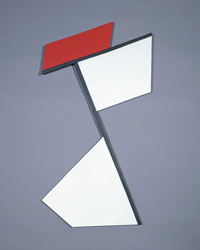
Lidy Prati
Concreto o Sin título, 1945
óleo sobre contrachapado
Colección particularPrati, Lidy
(Lidia Elena Prati)
Resistencia, Chaco,1921 – Buenos Aires, 2008
Painter, designer, and art critic
Prati was one of the few women to practice concrete art in the 1940s. She explored a vast repertoire of geometric forms, color strips, and juxtaposed shapes. In the mid-1950s, she abandoned painting and devoted herself to graphic, textile, and jewelry design.
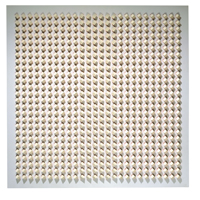
Luis Tomasello
Atmosphère chromoplastique
n° 352, 1974
Relieve de madera pintada
Galerie Denise RenéTomasello, Luis
La Plata, Buenos Aires, 1915
Tomasello explored geometric abstraction and carried out kinetic experiments on flat surfaces. His kinetic reliefs, consisting of sequences of black and white polyhedral elements arranged over blank surfaces, generated virtual movement and visual illusions. From the 1960s on, he experimented with light and shadow effects, the outcome of which was a prolific series entitled Atmosphère chromoplastique. These kinetic reliefs and plastic objects featured square shapes and wood rods cut at various levels and thickness. In the early 1980s, he pierced lines and small geometric shapes through black monochrome reliefs.
BRAZIL

Hércules Barsotti
Preto/branco, 1959-61
(Negro/blanco)
óleo y arena sobre lienzo
Colección Patricia Phelps de CisnerosBarsotti, Hércules
São Paulo, 1914
Painter, draughtsman, graphic and stage designer. He lives in São Paulo
Barsotti’s early work from the 1940s consisted of geometric abstract designs. While working as a textile and theater costume designer in the 1950s, he came into contact with artists drawn to concrete art. Towards 1960, he worked with monochrome black and white planes, emphasizing the subtle geometric spatial relations that exist between them. Barsotti’s departure from these contrasting compositions of black and white planes in 1963 gave way to his experiments with color and unconventional media to create a sense of movement and volume.
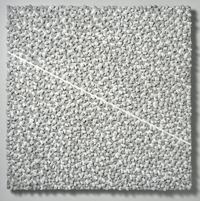
Sergio Camargo
Relevo n° 362, 1969
(Relieve n° 362)
Acrílico sobre madera
Colección Patricia Phelps de
CisnerosCamargo, Sérgio Río de Janeiro, 1930-1990
Painter and sculptor
He experimented with irregular structures made of sand, plaster, and fabric in the early 1960s and began the impressive series Relevos (Reliefs) in 1963. This series consisted of small wood cylinders arranged across a surface in various sequences and positions. In 1965, Camargo completed a wall relief for the headquarters of the Ministério das Relaçôes Exteriores in Brasília, housed in the building known as Palácio do Itamaraty designed by Oscar Niemeyer. During this period, he produced free-standing sculptures and began using Carrara marble, his preferred medium together with black granite from the 1970s onwards. Among his large-scale works for public spaces is the column Homagem a Brancusi (Homage to Brancusi) in Bordeaux, completed in 1972.
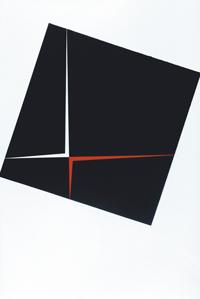
Lothar Charoux
Equilibrio restabelecido, 1960
(Equilibrio restablecido)
Gouache y acrílico sobre papel
Colección Glaucia y Peter Cohn,
São PauloCharoux, Lothar
Viena, 1912- São Paulo, 1987
Brazilian painter, draughtsman, and printmaker of Austrian origin
Influenced by Gestalt psychology, Charoux’s extensive series of paintings and drawings focused on the psychological factors that determine the spectator’s perception of form.
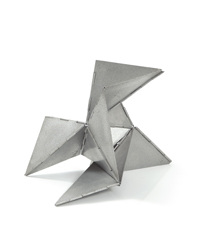
Lygia Clark
Bicho – maquete, 1960
(Bicho – maqueta)
Estructura en aluminio
Fundación privada Allegro
Cortesía de la Asociación
cultural O Mundo de Lygia Clark
Clark, Lygia
Belo Horizonte, Minas Gerais, 1923 – Río de Janeiro, 1988
Sculptress, painter, and performance artist
In the series Superficies moduladas (Modulated Surfaces) and Contrarevelos (Counter-reliefs), dating from the mid to late 1950s, Clark explored the significance of the plane as a structural component. From here, her interest gradually shifted to sculpture. In 1960 she proclaimed the “death of the plane,” claiming it did not stimulate interaction between the work and its surrounding environment. She then produced her first reliefs, which resemble folded sheets of paper, and a series of modulated sculptures entitled Bichos(Creatures). These metal structures are held together by hinges the spectator was free to alter and rearrange. In the 1960s she began executing a series of works entitled Goings.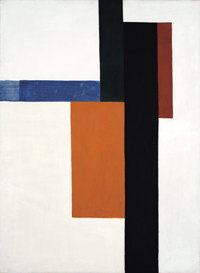
Waldemar Cordeiro
Sin título, 1949
óleo sobre lienzo
Colección Ella Fontanals-CisnerosCordeiro, Waldemar
Roma, 1925 – São Paulo, 1973
Brazilian painter, sculptor, landscape architect, art critic, and journalist of Italian origin
Transforming rigid geometric forms into free sequences throughout the late 1940s, he became a pioneer of concrete art in Brazil. From 1957 to 1959, in the series Idéais visíveis, he developed a type of abstract painting based on structural principles and logical concepts. In 1964, Cordeiro began blending features of pop and concrete art, creating a style of his own known as “pop creto.” He then returned to neo-figurative art and, towards the end of his career, experimented with digital and computer graphic design. Convinced of the important role art plays in society, he took part in over one hundred and fifty urban planning projects between 1950 and 1973.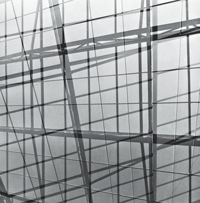
Geraldo de Barros
Estação da Luz – SP, 1949
(Estación de la Luz – SP)
Plata en gelatina, impresión vintage
Colección Museu de Arte Moderna
de São Paulo. Patrocinio PetrobrasDe Barros, Geraldo
Chavantes, São Paulo, 1923 – São Paulo, 1998 Photographer, painter, printmaker, and designer
De Barros’s interest in photographic techniques led him to abstract art. By isolating motifs and superimposing different images, the subject matter lost importance giving way to abstract geometric patterns with a somewhat urban feel. He continued exploring the possibilities of modern photography and, together with other photographers, founded the school commonly referred to as Escola Paulista. The Unilabor furniture was featured in various abstract compositions. The series Sobras (Leftovers) marked De Barros’s return to photography after a period of long absence.
Amílcar de Castro
Sin título, s. f.
Acero corten
Fundação José e Paulina
Nemirovsky, São PauloDe Castro, Amilcar
(Amilcar Augusto Ferreira de Castro Filho)
Paraisópolis, Minas Gerais, 1920 – Belo Horizonte, Minas Gerais, 2002 Sculptor, draughtsman, graphic artist and designer
His sculptures from the 1950s drew from constructivism. With the aim of reducing the volume of his sculptures, he cut and bent iron sheets. By manipulating iron, he sought to demonstrate the material was in fact flexible. Although he continued to develop this line of work well into the 1970s, graphic design eventually became his main area of interest. He used a coding system when referring to his sculpture: “Cut and bent sculpture from a square iron sheet” (also, “from a round sheet, a horizontal rectangular sheet, a vertical rectangular sheet,” and finally “in an irregular format”).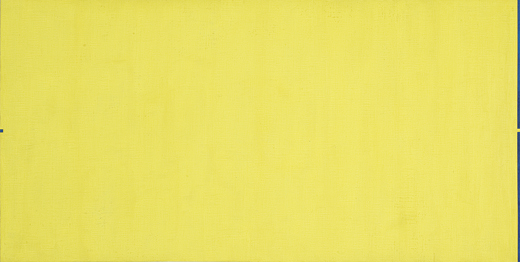
Willys de Castro
Objeto ativo, 1959
(Objeto activo)
óleo sobre lienzo sobre contrachapado
Colección MASP – Museu de Arte de São Paulo Assis Chateaubriand, São Paulo, BrasilDe Castro, Willys
Uberlândia, Minas Gerais, 1926 – São Paulo, 1988 Painter, draughtsman, printmaker, graphic and stage designer
Between 1959 and 1962, he worked on the series Objetos ativos (Active Objects). In order to grasp a general view of these apparently three-dimensional pieces, the spectator is required to contemplate their various fragments from successive viewpoints and subsequently associate the colored sides of the work. This series was followed by Pluriobjetos in the 1970s, a composition of vertical stainless steel sheets that transpose segments of color from one plane to another.

Thomaz Farkas
Cobertura do Cine Ipiranga,
São Paulo, SP, c 1945
(Techo del Cine Ipiranga,
São Paulo, SP)
Plata en gelatina
Colección Instituto Moreira SallesFarkas, Thomaz
Budapest, 1024 Brazilian photographer and filmmaker of Hungarian origin. He lives in São Paulo
During the 1940s, Farkas’ subject matter of choice was architecture, which allowed him abstract photographic compositions. He also produced documentaries and, as of 1958, documented the construction of Brasília, Brazil’s new capital, in a series of photographs. From 1968 to 1972, Farkas made a number of documentaries on cultural and social events taking place in Brazil during the dictatorship.

Hermelindo Fiaminghi
Círculos com movimento alternado,
1956
(Círculos con movimiento alterno)
Pintura sobre contrachapado
Colección Museu de Arte Moderna
de São Paulo. Adquisición Banco
Bradesco S. A.Fiaminghi, Hermelindo
São Paulo, 1920-2004
The son of Italian immigrants, Brazilian painter, teacher, and advertising and graphic designer
In 1953, he began incorporating circles and triangles in motion to his abstract-concrete compositions while making poem-posters of poet friends. The series Virtual (1958) focused on the tension that arises from the interaction between color and form, highlighting the spatial relations exposed by lithography. Beginning in 1960, Fiaminghi explored a concept he defined as retícula corluz (“colight reticulate”) and experimented with offset printing. As his work progressed, he named all his paintings Corluz, followed by their corresponding number. Due to their transparent and gestural qualities, these paintings appeared to the viewer as a mass of fluctuating color.

Gaspar Gasparian
Composição cubista, c 1950
(Composición cubista)
Plata en gelatina, impresión vintage
Colección Ella Fontanals – CisnerosGasparian, Gaspar
São Paulo, 1899-1966 Brazilian photographer, son of Armenian immigrants
Gasparian took up photography in 1940. He portrayed his subject matter of choice—São Paulo, its buildings and street life—with great romanticism. However, other photographs by the artist dating from the late 1940s and the early 1950s depict repetitive sequences of buildings, sidewalks, and everyday objects, resulting in elaborate compositions that hint at geometric rhythms.
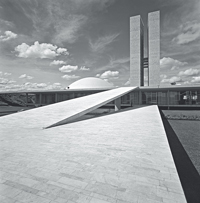
Marcel Gautherot
Palácio do Congresso Nacional,
Brasília DF, c 1960
(Palacio del Congreso Nacional,
Brasilia DF)
Plata en gelatina
Colección Instituto Moreira SallesGautherot, Marcel
Paris, 1910 – Río de Janeiro, 1996 Brazilian photographer of French origin
Gautherot managed photographic documents in the newly created Serviço do Patrimônio Histórico e Artístico Nacional. Everyday life and the religious and pagan celebrations of the São Francisco River region were his subject matter of choice during the 1940s. Together with photographer Pierre Verger, he documented modern and colonial architecture and, in the late 1950s, photographed Brasília’s new architecture with particular attention to geometric structures. Although black and white photographs make up most of his oeuvre, he took color photos from the 1970s onwards.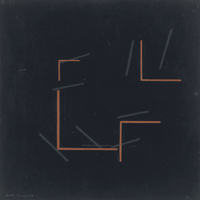
Judith Lauand
Concreto 18, 1956
Pintura sintética sobre aglomerado
Colección Patricia Phelps de
CisnerosLauand, Judith
Pontal, São Paulo,1922
Painter and printmaker. She lives in São Paulo
Lauand’s work from the 1950s drew from an expressive form of abstract art but became increasingly rigid and analytical from 1954 onwards. Throughout the 1960s, unconventional objects such as paper clips made their way into her compositions, resulting in unusual surfaces and optical illusions.
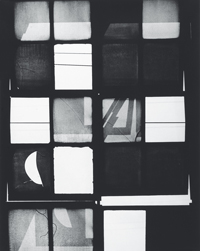
German Lorca
Homenagem a Mondrian, 1960
(Homenaje a Mondrian)
Plata en gelatina, impresión vintage
Colección Museu de Arte Moderna
de São Paulo.
Adquisición: Núcleo Contemporâneo
MAM-SPLorca, Germán
São Paulo, 1922
Photographer. He lives in São Paulo
Lorca’s main subject matter is the city. The sharp contrasts in his black and white photographs bring them close to abstract art compositions.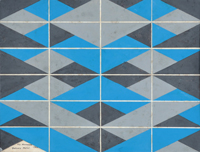
Antônio Maluf
Estudo Vila Normanda, 1964
(Estudio Villa Normanda)
Gouache sobre cartón
Colección particularMaluf, Antônio
São Paulo, 1926 – 2005 Painter, draughtsman, and designer
Maluf abandoned his early figurative style in the 1950s in favor of constructivist-geometric compositions, as seen in the series Equação dos desenvolvimentos (Equation of Development) which incorporated motifs inspired by advertising that had already appeared in his poster for the first Bienal de São Paulo in 1951. He explored the applications of visual rhythm in the series Progressões crescentes o descrecentes (Increasing and Decreasing Progressions) and continued to develop this technique throughout the 1960s working on a number of murals. Together with architects Fábio Penteado and Lauro da Costa Lima, Maluf executed several glazed ceramic wall murals in the city and state of São Paulo. He also worked in the textile design and advertising industry, creating logotypes and ads.
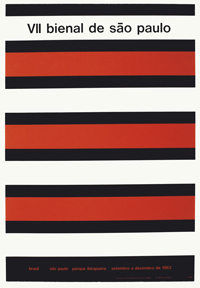
Almir Mavignier
Cartel de la VII Bienal de São
Paulo, 1963
Serigrafía
Colección del Museu de Arte
Moderna de São Paulo.
Donación del artista Mavignier, Almir (Almir da Silva Mavignier)
Río de Janeiro, 1925
Painter, graphic artist, and designer Hamburgo
From 1952 onwards he himself entirely to concrete art, His experiments dealt with the interplay between color, form, and light within a square surface. He executed the paintings Punktbilder (Dot Paintings) in 1954 and Rasterbilder (Reticulate Paintings) in 1955. These were followed by op-art influenced paintings in 1956, monochrome works in 1957, a series of silk screen prints entitled Permutaçôes (Permutations) from 1959 to 1961, and the black and white paintings Côncavo-convexo (Concave-Convex) in 1962. Additive Plakate (Additive Posters) from 1963 is a composition of systematically arranged forms that admits an endless association of elements. Other works include mono-polychrome paintings (1974), monochrome structures reflecting light and shadows (1975), and a series entitled Divisão-rotação (Division-Rotation, 1981), consisting of rotating devices that free color from form.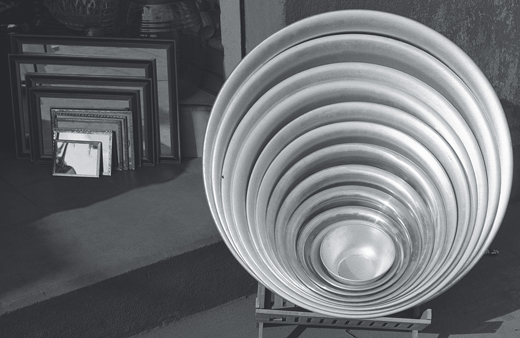
Haruo Ohara
Turbilhão. Londrina-PR, 1957
(Torbellino. Londrina-PR)
Plata en gelatina
Colección Instituto Moreira SallesOhara, Haruo
Kochi, Japón, 1909 – Londrina, Paraná, 1998 Brazilian photographer and farmer of Japanese origin
Ohara documented the history of Londrina as well as his family’s experiences in rural Brazil, images illustrative of the life of many Japanese immigrants. His precise compositions and panoramic views show the influence of geometric and serial structures. In the late 1970s he shifted from black and white to color photography.
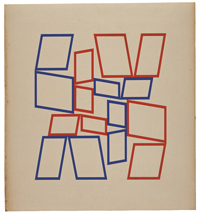
Hélio Oiticica
Metaesquema n° 4066, 1958
Gouache sobre cartón
The Museum of Modern Art,
Nueva York.
Donación de la familia Oiticica, 1997Oiticica, Hélio
Río de Janeiro, 1937 – 1980 Sculptor, painter, performance artist, and theorist
In the Metaesquemas (Metaschemes) series from the 1950s, Oiticica created an unstable structure by dividing the surface into segments. Like Lygia Clark, he questioned the predominance of the flat surface in concrete art. The result of these inquiries was Relevos espaciais (Spatial Reliefs), which led to Penetráveis (Penetrables), installations made of suspended monochrome fabrics. The series Parangolés (slang for a situation of sudden confusion or excitement among people) from the 1960s consisted of plastic objects that could be used as garments and required viewer participation, an aspect explored by the artist. As Oiticica believed dance was a source of aesthetic inspiration, he took samba lessons, earning him the nickname “passista.” Other significant works include Nuclei, a color maze of screens, and Bolides, fireballs made of insignificant materials. He also made films and published theoretical texts.
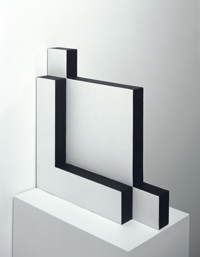
Lygia Pape
Sin título, 1961
Acrílico sobre contrachapado
Colección Patricia Phelps de CisnerosPape, Lygia
Nova Friburgo, Río de Janeiro, 1927 – 2004 Sculptress, graphic artist, and filmmaker
As a graphic artist, Pape studied the behavior and reproducibility of geometric images in a number of prints and woodcuts. In the series Tecelares (Textiles), for example, geometric shapes merge with the wood’s natural lines. Pape also designed jewelry. In collaboration with the choreographer Gilberto Mota and the poet Reynaldo Jardim, she worked on a neo-concrete ballet in 1958–59. The production featured concrete music by Pierre Henri and displayed abstract forms set into motion by imperceptible human bodies. Pape’s book Livro da criação, published in 1959, describes the creation of the universe in terms of form and color, encouraging the reader to participate. In the 1960s, she became involved in the film industry, producing short films and joining the “Cinema Novo.” Large-scale installations from the 1970s include Teia (Fabric), Ovos do vento (Wind Eggs), and Luar do sertão (Sertão Moonlight), all of which require the spectator to interact with the work.
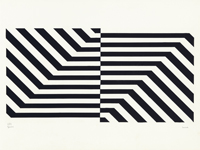
Luiz Sacilotto
Gouache n° 272, s. f.
Gouache sobre papel
Fundación privada AllegroSacilotto, Luiz(o Luís)
Santo André, São Paulo, 1924 – São Bernardo do Campo, São Paulo, 2003 Brazilian painter, sculptor, draughtsman, and printmaker, son of Italian immigrants
During the 1940s, Sacilotto painted portraits in an expressionist style; however, his still lifes progressed towards geometric abstraction in 1947. From then on, concrete art dominated his paintings, which are entitled Concreção followed by their corresponding number. Influenced by the work of Mondrian in the 1950s, Sacilotto created orthogonal structures arranged by color, to which he added small patterns of horizontal and vertical lines over a light background. In subsequent years, rectangular and triangular grids appeared in both his paintings and his sculptures. Featuring vibrating visual effects, these pieces can be considered forerunners of op-art, the dominant style of his output during the 1970s and 1980s.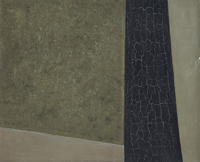
Mira Schendel
Sin título, 1960
óleo sobre lienzo
Fundación privada AllegroSchendel, Mira (Myrrah Dagmar Dub)
Zúrich, 1919 – São Paulo, 1988 Brazilian painter and poetess of Swiss origin
Schendel began her career creating abstract-constructivist compositions and exploring the geometric relations between line, plane, space, and color, fruit of which were monotypes, letters, words, and graphic symbols. Between 1964 and 1974 her production featured lines and letters arranged over translucent backgrounds, as seen in the series Monotipias (Monotypes), Droguinhas (Trifles),and Trezinhos (Little Trains), in which she emphasized the paper and pigments’ textural qualities. Other series, such as Toquinhos from the 1970s, manifest Schendel’s interest in transforming letters and linguistic elements into objects, an approach that has much in common with concrete poetry and the principle that typography should be a significant part of the poetic-visual work rather than just a formal element. Impressed by Carl Gustave Jung’s psychoanalytical theories and Chinese oracles, Schendel executed the series I Ching in the 1980s.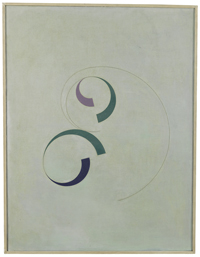
Ivan Serpa
Sin título, 1954
óleo sobre lienzo
Colección Patricia Phelps de CisnerosSerpa, Ivan (Iván Ferreira Serpa)
Río de Janeiro, 1923 – 1973 Painter, printmaker, and designer
Serpa’s first abstract works date from 1951. He developed serial compositions in his paintings and tried to fuse them with architecture. His work experience at the National Library also determined his artistic output, especially the paper collages in which he experimented with conservation and restoration techniques and methods. The expressive series Fase negra (Black Phase) from 1962 alludes to the country’s heated political situation. In the mid-1960s he returned to a freer form of geometric art, closer to kinetic and op art.
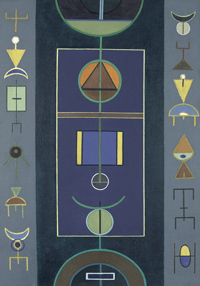
Rubem Valentim
Sin título, 1956-62
óleo sobre lienzo
Colección Patricia Phelps de CisnerosValentim, Rubem
Salvador de Bahía, 1922 – São Paulo, 1991 Painter, sculptor, and printmaker
As a child, Valentim drew landscapes and figures. He formed part of a movement aiming to renew art in Bahia in the 1940s. Under the influence of popular and African art in the 1950s, he created a geometric language that included ritualistic and totemic signs and symbols of Afro-Brazilian culture. Valentim’s signature repertoire of symbols appears in his vivid and bright paintings, wood cuts, and painted wood objects and sculptures.
Alfredo Volpi
Composição concreta branca e vermelha, 1955
(Composición concreta blanca y roja)
Témpera sobre lienzo
Colección Rose y Alfredo SetubalVolpi, Alfredo
Lucca, Italia, 1896 – São Paulo, 1988 Brazilian painter and muralist of Italian origin
Volpi’s early work drew from post-impressionism, as evidenced in his landscapes, seascapes, and representations of villas and façades executed in subdued earth-colored tones. His interest in religious and popular subject matters brought him closer to geometric abstraction in the 1940s. In the 1950s, concrete art came to dominate the series entitled Triângulos em tangência (Triangles at a Tangent), which led to his signature work Bandeirinhas (Flags). In the series Mastros (Masts), ocean motifs take up the entire surface of the painting, either as individual figures or fused together. During the 1970s, Volpi created dynamic visual effects by painting knots of flags intersected by masts and arches. Other recurring motifs include façades, building components, sails, and boats, elements he arranged in simple two-dimensional compositions. From the beginning of his career, Volpi also executed murals and church stained glass windows.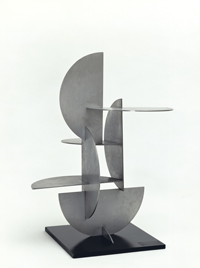
Franz Weissmann
Composição com semicírculos, 1953
(Composición con semicírculos)
Aluminio
Colección Patricia Phelps de CisnerosWeissmann, Franz (Franz Josef Weissmann)
Knittelfeld, Austria, 1911 – Río de Janeiro, 2005 Brazilian sculptor, painter, and draughtsman of Austrian origin
Weissmann’s early representational work featured human figures which he progressively simplified, marking his transition to a form of geometric abstraction in the style of Constantin Brancusi and Henry Moore. Influenced by Max Bill, in the early 1950s he executed his first abstract works in iron and stainless steel, the beginning of a long list of series including Cubo vazado (Emptied Cube, from 1951) and Cubo aberto (Open Cube, from 1952). These were followed by a series sculptures that resembled drawings in space, entitled Escultura linear (Lineal Sculpture, from 1954). Weissmann was eager to experiment with cubes and blocks, as seen in Coluna concretista (Concrete Column, from 1952) and Coluna neoconcreta (Neo-Concrete Column, from 1958). Inspired by his travels to the Middle East in the 1960s, he executed the strikingly expressive and spontaneous series Amassados, consisting of sculptures made of zinc, burlap, plaster, and aluminum. He returned to constructivism following this interlude and produced modulated artifacts such as Módulos mutáveis (Mutable Modules, 1967), Arapuca, and Torre vermelha (Red Tower, 1967), in which he used color to create vibrating visual effects. Weissmann also designed works for public spaces in São Paulo (Grande flor tropical, 1989, Memorial da América Latina), Rio de Janeiro, and Belo Horizonte, among other cities.
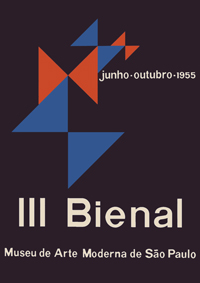
Alexandre Wollner
Cartel de la III Bienal de São Paulo
en el Museu de Arte Moderna, 1955
Impresión digital, 2010
Colección particularWollner, Alexandre
São Paulo, 1928 painter, photographer, graphic and industrial designer, son of Yugoslav immigrants. He lives in São Paulo
He then took up graphic design after encountering the innovative visual work of Paul Rand and Alexey Brodovitch. Under the influence of concrete painting in the early 1950s, he adapted the style to his graphic drawings and advertisements. As a student in Ulm, Wollner executed several posters, a form of art he returned to years later creating film posters in collaboration with Geraldo de Barros. A pioneer of abstract and industrial design in Brazil, Wollner has created corporate logotypes for companies across Brazil. Among his clients are Ibesa, Coqueiro, Argos Industrial, Coretron, Metal Leve, Equipesca, Ultragaz, Grupo Hansen, Mausa, Brasilit, Itaú, São Paulo Petróleo, and several publishing houses.
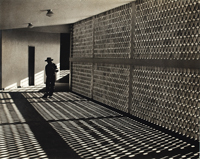
José Yalenti
Fasciceiro, c 1960s
Plata en gelatina, impresión vintage
Colección Ella Fontanals – CisnerosYalenti, José (José Vicente Eugênio Yalenti)
São Paulo, 1895-1967 Brazilian photographer, son of Italian immigrants
Yalenti photographed architectural elements which he transformed into geometric structures through the use of light.
COLOMBIA
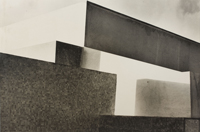
Leo Matiz
Abstracto, USA, 1950
Plata en gelatina, impresión vintage
Colección Ella Fontanals–CisnerosMatiz, Leo
Aracataca, Magdalena, 1917 – (Santafé de) Bogotá, 1998 Photographer, painter, draughtsman, and caricaturist
Encouraged by Colombian photographers Luis B. Ramos and Juan N. Gómez, as well as Mexican photographer Gabriel Figueroa, he took up photography professionally. Important sources of subject matter included everyday country and city life, daily work, architecture, and industry. While living in Venezuela, Matiz documented key political, social, and cultural events. He also excelled at portraiture and photographed several artists and politicians, including Frida Kahlo, Mexican muralists José Clemente Orozco, Diego Rivera, and David Alfaro Siqueiros, María Félix, Agustín Lara, Camilo Torres, Pablo Neruda, Salvador Allende, Fidel Castro, Luis Buñuel, and León de Greiff. The influence of geometric abstraction is evident in several of these portraits, in which Matiz underlined the use of backlight. He also created different effects as the light streamed over everyday objects, some of which were found in nature, while others were man-made.
CUBA
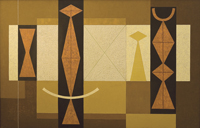
Mario Carreño
Encuentro inesperado, 1952
óleo sobre lienzo
Colección Museo Nacional de Bellas
Artes, La HabanaCarreño, Mario (“Karreño”)
La Habana, 1913 – Santiago de Chile, 1999 Painter, muralist, sculptor, draughtsman, printmaker, illustrator, and art teacher
His early painting was influenced by Picasso’s neo-classical period and the work of Jamie Colson and Diego Rivera. Notable figurative paintings representing tropical and West Indian subject matter include Descubrimiento de las Américas (Discovery of the Americas, 1940), Danza afrocubana (African Dance, 1943), and Cortadores de caña (Cane Cutters, 1943). From the 1940s on his work portrayed stylized figures that gradually evolved into geometric abstraction, his dominant style in the 1950s. In Chile, he moved towards a somewhat tragic type of surrealist painting, illustrating fragmented characters such as dolls against a desert backdrop. In the series El mundo petrificado (The Petrified World, 1964) and Serie post-atómica (Post-Atomic Series, 1965) he expressed his concern over war and the destruction of mankind. He later returned to his tropical repertoire of symbols in a series of stylized metaphorical compositions.
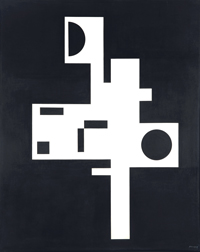
Salvador Corratgé
Nueva unidad formal plana abierta
en 3 fases distintas sobre un punto
de apoyo, 1961
óleo sobre lienzo
Colección privada, La HabanaCorratgé, Salvador (Salvador Zacarías Corratgé Ferrara)
La Habana, 1928 Painter, draughtsman, ceramist, photographer, graphic designer, silversmith, and printmaker. He lives in La Habana
Corratgé’s body of work forms part of Cuban concrete art. However, his style was not confined to rational and mathematic principles or a dogmatic conception of form and color. Rather, he incorporated moving, harmonic, and sensitive elements, providing his production with a personal yet wide-ranging subject matter. Colors vary from pristine shades of white and black to louder hues, while forms shift from line to dot, and circle to square. Corratgé created an infinite number of geometric combinations, engaging structures that were fundamental to his work. Inspired by the music of Johann Sebastian Bach, Frédéric Chopin, and Hans Werner Henze, he began exploring the relation between painting and music during the 1970s. His studies led to the series of paintings Notaciones plásticas (Plastic Notations) and Ensayos lineales (Linear Studies). Although his abstract artwork from the 1990s showed signs of dynamic expressionism, it tended towards concrete art, as evidenced in Persiguiendo al cuadrado (Chasing the Square, 2005). Corratgé also designed large-scale works such as the Mausoleo a los Mártires de Pino 3 (1975) and a cement mural relief in Camagüey.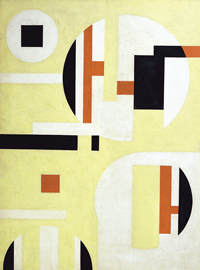
Sandu Darie
Multivisión espacial, 1955
óleo sobre lienzo
Colección Museo Nacional de Bellas
Artes, La HabanaDarie, Sandu
Roman, Neamt, 1908 – La Habana, 1991 Cuban painter, sculptor, draughtsman, ceramist, and stage designer of Romanian origin
Darie took up painting professionally in the mid-1940s, executing lyrical abstract works that conveyed tropical light and nature. Composiciones (Compositions, 1949) represented geometric lines immersed in broad stains of bright color, while Estructuras pictóricas (Pictorial Structures, 1950) experimented with the frame and its boundaries in space and time. He began to explore kinetic art in Estructuras transformables (Transformable Structures, 1955–56). His inquiries resulted in Cosmorama (1963). In 1969, Darie was invited to take part in an international joint project, the kinetic-light installation at Place du Châtelet in Paris. He also designed the kinetic-light towers at the Parque Lenin Floating Amphitheater. From 1975 to 1985, Darie was involved in a series of social projects, to which he brought his experience as a concrete artist. He combined kinetic-light environments with both static and mobile architectural installations, as well as urban structures (Cuatro Caminos, Palacio Central de Pioneros, Hospital Clínico Hermanos Ameijeiras, Central Electronuclear in Cienfuegos, and the Centro de Ingeniería Genética y Biotecnología in Cubanacán). Entre 1975 y 1985 desarrolla una intensa actividad de servicio social, a la que incorpora muchas ideas que son el resultado de sus experiencias con el arte concreto. A ambientaciones lumino-cinéticas agrega instalaciones estructurales ‒estáticas o móviles‒ y luminosas de reanimación urbana.

Carmen Herrera
White and Green, 1959
(Blanco y verde)
Acrílico sobre lienzo
Tate: prestado por el American
Fund para la Tate Gallery, cortesía
de Ella Fontanals Cisneros 2006Herrera, Carmen
La Habana, 1915
American painter and sculptor of Cuban origin. She lives in New York
As an illustrator for the series Habana (1950–52), Herrera’s work showed signs of surrealist abstraction but shifted to geometric abstraction during her formative years in Paris. In these paintings, she used bright colors and contrasted optical rhythms, thus anticipating distinctive features of kinetic and op art. After settling in New York, she followed in the footsteps of Ellsworth Kelly but chose to create smaller pieces. With time, she forged a consistent yet simple and insightful body of work. By combining a small number of rectangular forms in black and white or in two solid colors, she came close to achieving a minimalist style of painting
Luis Martínez Pedro
Aguas territoriales n° 5, 1962
óleo sobre lienzo
Colección Museo Nacional de Bellas
Artes, La HabanaMartínez Pedro, Luis
La Habana, 1910-1989 Painter, draughtsman, illustrator, ceramist, and designer
During the 1930s, Martínez Pedro focused on social subject matters but gradually evolved towards surrealism and expressionism. Themes included tauromachy, indigenous legends, and Afro-Cuban rites. He then turned to a concrete form of geometric abstraction in 1951. From 1959, he painted sea-related subjects, examples of which include Aguas territoriales (Territorial Waters) and Signos del mar (Sea Signs). In addition to working as a graphic and industrial product designer, he also designed costumes for theater and dance productions and was involved in making educational films. Among his illustrations for books and magazines are Cuatro canciones para el Ché (1969) by Nicolás Guillén and El mundo silencioso (1973) by Jacques-Yves Cousteau. In the mid-1970s, Martínez Pedro began the series Flora cubana—paintings depicting Cuban nature and indigenous flora—while designing building murals in Havana.
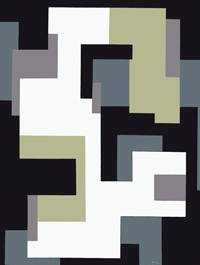
José Mijares
Estabilidad, 1959
Acrílico sobre lienzo
Colección Museo Nacional de Bellas
Artes, La HabanaMijares, José
La Habana, 1921 – Coral Gables, Florida, 2004 Painter, draughtsman, and printmaker
Following an early figurative period, in 1953 Mijares began experimenting with concrete forms based on solid colors and non-representational shapes. These balanced compositions represent gradual progressions of color. He later returned to figurative painting, a style he practiced to the end of his career. Mijares’s somewhat wistful subject matter of fishermen, sad harlequins, and melancholic women, as well as his particular use of color, became distinctive features of his work. Meticulous yet personal, his paintings also incorporate spectacular and surreal elements.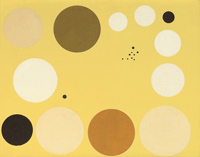
Loló Soldevilla
Carta celeste en amarillo n° 1,
París, 1953
óleo sobre lienzo
Colección Museo Nacional de
Bellas Artes, La HabanaSoldevilla, Loló (Dolores (Loló) Soldevilla Nieto)
Pinar del Río, 1901 – La Habana 1971 Painter, sculptress, draughtswoman, printmaker, and art critic
Circles, squares, and light were predominant features of Soldevilla’s concrete artwork. Together, these components form poetic spaces, evocations of a celestial and starry universe. Though her two-dimensional paintings resemble those of Sophie Taeuber-Arp, Soldevilla’s stand out for their formal serenity, defined contours, rhythmic patterns of black and white, and compositional elements. She also executed luminous reliefs, to which she incorporated artificial light. Following the Cuban Revolution, she carried out more general tasks within the cultural sector.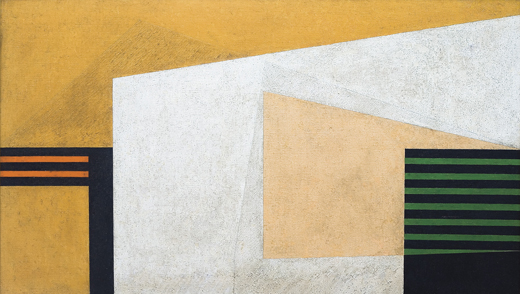
Rafael Soriano
Sin título, s. f.
óleo sobre lienzo
Colección Museo Nacional de Bellas Artes, La HabanaSoriano, Rafael American painter, draughtsman, and graphic designer of Cuban origin. He lives in Miami, Florida
Soriano embraced geometric abstraction in the 1940s. His early work showed concrete features and later alluded to cosmic elements. Inspired by Sebastián Matta, during the 1970s he executed hazy landscapes evocative of erotic emotions and shapes. He created a luminous and oneiric repertoire of soft and biomorphic shapes and volumes set against a dark backdrop, representing the spatial realm of the unconscious. His palette was restricted to dim, harmonious colors. Soriano’s entire body of work shares this surreal quality expressed in an esoteric, mystical, chimerical, and astral style.
MÉXICO
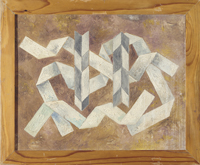
Germán Cueto
Planos (Homenaje al músico
Silvestre Revueltas), 1940
óleo sobre madera
Colección privada, cortesía
de Freijo Fine Art, Galería de arte
y proyectosCueto, Germán (Germán Gutiérrez Cueto)
México, D. F., 1893 – 1975
Despite being a pioneer of modern sculpture in Mexico and Latin America, Cueto did not achieve recognition during his lifetime and was almost forced to live in exile. His work sits between abstract sculpture and the art of mask-making. Materials used include metal sheets, aluminum, paper, wire, glass, plastic, brass, and stone. He also worked as a stage designer and teacher. During the 1940s he created masks for ballets using concrete, power cable, and metal wire. From 1941 to 1945 he executed large abstract drawings in black or color pencil. Notable large scale sculptures include El corredor (The Runner) for the Route of Friendship, made on occasion of the XIX Olympic Games held in Mexico City in 1968.
URUGUAY
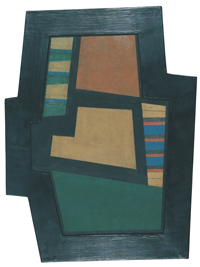
Carmelo Arden Quin
Sin título o Composición, 1945
óleo sobre cartón y madera lacada
Malba – Fundación Costantini, Buenos AiresArden Quin, Carmelo (Carmelo Heriberto Alves Oyarzum)
Rivera, Uruguay, 1913 – Savigny-sur-Orge, near Paris, 2010 French painter, sculptor, and poet of Uruguayan origin
Arden Quin’s early work was primarily cubist. In 1935 he completed his first non-figurative geometric work and, transcending the boundaries of traditional painting, executed his first non-orthogonal paintings the following year. In the mid-1940s he explored polygonal shapes and designed modulated and mobile structures, coplanar pieces, object-paintings and concave-convex objects. He continued working in Paris, where he experimented with collage and decoupage (molding), his preferred technique until 1971. That same year, he returned to painting and his signature compositions of voluminous shapes intersected by black lines, which he called Formes galbées (Shaped Forms).
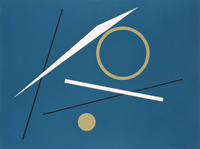
José Pedro Costigliolo
Composición, 1953-54
Laca sobre metal
Museo Nacional Centro de Arte
Reina Sofía, Madrid
Costigliolo, José Pedro
Montevideo, 1902-1985 Painter, draughtsman, graphic artist, and designer
Together with María Freire, Costigliolo was one of the pioneers of non-figuration in Uruguay. Influenced by Russian constructivism and Dutch neo-plasticism, his works shifted to neo-purism and machinist aesthetics in 1946, as evidenced in his figurative painting and still lifes. In 1950, his work acquired abstract-geometric features and orthogonal elements. Following a brief experience with Art Informel in 1960 (works which he later destroyed), Costigliolo began adding letters to his compositions. These were followed by his signature works, which initiated a period of artistic maturity. Throughout the 1960s, he perfected these seriesentitled Triángulos (Triangles), Rectángulos (Rectangles) and Cuadrados (Squares), structures consisting of geometric forms arranged either separately or as part of a composition and featuring a limited range of color: in addition to red and black, he applied tones of blue, lilac, purple, and brown. Costigliolo also executed large-scale works such as ceramic murals and stained glass windows.
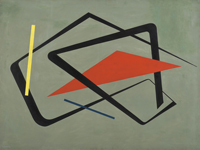
María Freire
Sin título, 1954
óleo sobre lienzo
Colección Patricia Phelps de CisnerosFreire, María
Montevideo, 1917
Painter, sculptress, draughtswoman, and art critic. She lives in Montevideo
Along with her partner José Pedro Costigliolo, Freire was a pioneer of non-figurative art in Uruguay. Inspired by planismo, cubism, and African art during the 1940s, her early work was somewhat abstract. In the early 1950s she devoted herself to painting and sculpture. Her output from this period is fundamentally geometric and marks the beginning of early Madí art. Freire used a limited range of colors, as she preferred to underscore the delicacy and musicality of geometric form. In subsequent decades, she constructed a variable formal repertoire composed of a small number of components. The series Sudamérica (South America, 1958–60) was characterized by its precise contours, resulting in a symbol constructed as a polygonal shape. By perforating the object’s surface in the series Capricornio and Córdoba (1965–75), Freire created a nodal point through which the work could expand infinitely. In the later series Variantes and Vibrantes (1975–85), she focused on the possibilities of altering the surface’s volume by subdividing the surface. As a result, she obtained reliefs and vibrating effects consistent with modular chromatic sequences, much in the line of op art.
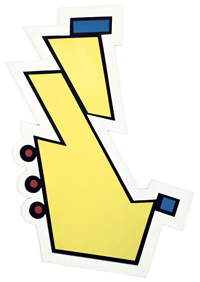
Rod Rothfuss
3 círculos rojos, 1948
Esmalte sobre madera
Malba – Fundación Costantini,
Buenos Aires
Rothfuss, Rhod (Carlos María (Rhod) Rothfuss)
Montevideo, 1920-1969 Painter and sculptor
Between 1945 and 1950, Rothfuss created abstract sculptures with mobile components and incorporated irregular, mobile, geometric figures in his paintings. As pointed out by the artist, “a painting should begin and end in itself. It should not be offered continuity.” Rothfuss studied the effects adjacent polygons had on perception, a subject he examined in the article “Un aspecto de la superposición,” published in the second issue of Madí magazine in 1948.
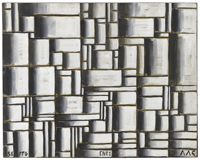
Joaquín Torres-García
Estructura en blanco y negro, 1938
óleo sobre papel montado sobre madera
The Museum of Modern Art, Nueva York.
Donación de Patricia Phelps de
Cisneros en honor a David Rockefeller, 2004
Torres-García, Joaquín
Montevideo, 1874-1949 Painter, sculptor, and draughtsman
During his youth, Torres-García formed part of Catalan Noucentisme, a primarily classic movement based on a Mediterranean tradition inspired by the monumental and pastoral style. In the late 1920s he turned to constructivism. Impressed by prehistoric and pre-Columbian art, over the next twenty years Torres-García developed what came to be known as constructive universalism, a style that aimed at uniting the visual arts by fusing Indoamerican art and European constructivism.
VENEZUELA
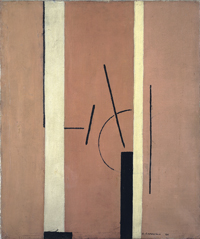
Omar Carreño
Tema tres tiempos n° 22, 1950
óleo sobre lienzo
Colección Patricia Phelps de CisnerosCarreño, Omar
Porlamar, Nueva Esparta, 1927
Painter, sculptor, goldsmith, and architect. He lives in Caracas
Carreño’s early work was influenced by geometric abstraction. Following this period, in the 1950s he developed expansionism. Notable works in this style include reliefs, some of which incorporated metal components, object-paintings such as Ojos de Buey (Portholes), adjustable polyptychs, and a series of lacquered objects and sculptures entitled Hierros estables (Stable Irons). He became involved in the synthesis of the arts project at the Caracas University Campus, where he executed mural paintings at the School of Dentistry. Between 1960 and 1965, his artistic style moved towards Art Informel, though he later returned to geometric abstraction. He experimented with transformable objects made of cubes and explored the possibilities of incorporating artificial light to artworks. Between 1985 and 1992 his production entered a figurative-abstract phase dominated by sailboat motifs which subsequently gave way to abstract reliefs.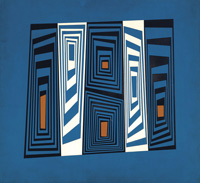
Carlos Cruz-Diez
Vibración del negro, 1957
óleo sobre madera
Fundación privada AllegroCruz-Diez, Carlos
Caracas.1923
Sculptor, painter, draughtsman, illustrator, and designer. He lives in Paris
Throughout the 1950s Cruz-Diez illustrated several books published by the Venezuelan Ministry of Education. In 1955 he began exploring the possibilities of creating virtual color in relation to the spectator’s movement, a subject he treated in his Fisicromías (Physichromies). In line with his idea of transforming color, Cruz-Diez created the environments Transcromías (Transchromies) and Cromosaturaciones (Chromosaturations). He also executed several works that combined kinetic art, urban space, and architecture. Some, like Transchromies for the Phelps Tower Gates (1967) in Caracas, were permanent structures, whereas others were temporary pieces. Examples of the latter are Chromosaturation pour un lieu public (Paris 1967) and Chromatic Environments for Guri Dam Powerhouse (1980s).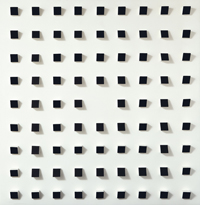
Narciso Debourg
En Blanc et noir (En torno al blanco), 1953
(En blanco y negro)
Ensamblaje en madera y pintura Duco
Fundación privada AllegroDebourg, Narciso
Caracas, 1925
Sculptor. He lives in Paris
As a kinetic sculptor, his work features optical structures consisting of cylinders or solid geometric structures arranged on a flat surface. By cutting tubular objects diagonally, Debourg also creates different light effects.
Gego
Partiendo de un rectángulo II, 1958
Tiras de aluminio dobladas y atornilladas
Fundación privada AllegroGego (Gertrud Louise Goldschmidt)
Hamburgo, 1912 – Caracas, 1994 Venezuelan sculptress, draughtswoman, printmaker, and architect of Jewish and German descent
From the mid-1950s, she concentrated on abstract drawing and, encouraged by Alejandro Otero and Jesús Soto, created three-dimensional works, first using paper and subsequently iron. In these pieces she was able to convey parallel lines and planes projecting onto curved surfaces. In 1964 she began to employ stainless steel wire—a light and flexible medium—leaving her previous structures of parallel lines behind in the late 1960s. She then began to create designs by interlacing lines in triangular shapes which gave way to flat and modular grid structures. Various versions of Gego’s three-dimensional work Retícularea, an architectural installation made of webs and nets, stemmed from these earlier structures. The first Retícularea was displayed at the Museo de Bellas Artes de Caracas in 1969. In the early 1970s she designed similar grid structures, this time incorporating round or square shapes and iron or aluminum rods. These works sometimes allude to natural phenomena as in Chorros; Nubes; Troncos; Esferas (Streams; Clouds; Trunks; Spheres). Dibujos sin papel (Drawings without Paper) marked the beginning of a third period in the mid-1970s. This series allowed Gego great freedom of expression, as she drew in the air using wire and other metal materials. In her later work entitled Tejeduras (Weavings, 1988–89) she used strips of paper and tin sheets.
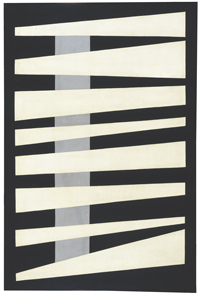
Mateo Manaure
El negro es un color, 1954
Pintura sintética sobre aglomerado
Colección Patricia Phelps de CisnerosManaure, Mateo
Uracoa, Monagas, 1926
Painter, muralist, sculptor, printmaker, graphic designer. He lives in Uracoa.
Manaure’s early figurative work featured nudes, landscapes, and still lifes executed in a gestural and surrealist style. In Paris, his production gradually shifted from geometric abstraction to lyrical abstract art. He played an active part in the synthesis of the arts project in the University Campus of Caracas, completing several abstract geometric murals, polychrome works, and stained glass windows. In the early 1960s he returned to figurative art, to which he added magical and surreal elements. Examples include a series of photographic collages entitled Sobremontajes (Overmontages, 1965) and Los suelos de mi tierra (The Soil of my Land, 1967). His return to geometric abstraction was marked by Cuvisiones (1970), in which the cube forms the central theme of the work, and Columnas policromadas (Polychrome Columns, 1977), a serial and systematic arrangement of sculptures. Manaure’s output remains poised between geometric art and schematic figuration with symbolic and mythical features.

Alejandro Otero
Coloritmo 45A, 1960
Pintura Duco sobre madera
Fundación privada AllegroOtero, Alejandro El Manteco, Bolívar, 1921 – Caracas, 1990
Painter and sculptor
Otero began his career in the late 1940s painting geometric compositions of still lifes, such as Cafeteras (Cofee pots). He executed aluminum panels and mosaics for the Caracas University Campus project, works that led to the series Coloritmos (Colorhythms). While living in Paris in the 1960s, he completed a series of assemblages and collages that incorporated everyday objects in the style of neo-Dada. Otero also designed several abstract urban sculptures, including Estructuras espaciales (Spatial Structures) in Maracay (1968), Bogotá (1975), Washington D.C. (1975), Mexico City (1975), Milan (1977), and Guri Dam, Venezuela (1987).
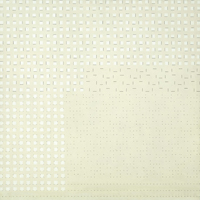
Jesús Rafael Soto
Rotation, 1952
(Rotación)
óleo sobre contrachapado
Centre Pompidou, París. Musée
national d’art moderne / Centre de
création industrielle. Adquisición en 1980Soto, Jesús Rafael
Ciudad Bolívar, Bolívar, 1923 – Paris, 2005
Painter and sculptor
Influenced by the work of Marcel Duchamp, Yaacov Agam, and Jean Tinguely, throughout the 1950s Soto used optical effects rather than mechanic devices with the aim of setting his paintings into motion. In 1958, he created the series Vibraciones (Vibrations), comprised of suspended elements arranged before a geometric structure that seem to shift as the spectator moves. The series entitled Escrituras (Writings, 1963) is based on these same principles. In the late 1960s he began work on Penetrables, an installation made of plastic and metallic rods through which the spectator can move. Soto received several commissions, including two kinetic murals for the Venezuelan Pavilion at the 1958 Brussels World Fair, Volumen suspendido (Suspended Volume) for Expo 67, the Universal and International Exhibition in Montreal, as well as large-scale reliefs for the UNESCO building in Paris (1970) and the Museo de Arte Contemporáneo de Caracas (1971).
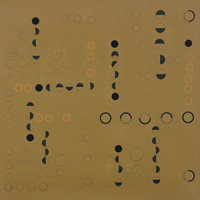
Víctor Valera
Sin título, 1951
Témpera sobre lienzo
Fundación privada AllegroValera, Víctor Maracaibo, Zulia, 1927
Painter, sculptor, and stage designer. He lives in Caracas
Valera began his career making stylized figurative works. While living in Paris, he experimented with optical effects on stable surfaces. Following his return to Venezuela and encouraged by Danish sculptor Robert Jacobsen, he began using welded iron. Valera explored the properties of volume by taking apart and assembling metal sheets. He was among the first artists involved in the Caracas University Campus project, executing abstract ceramic murals for various schools as well as other buildings between 1954 and 1958. In the 1960s he completed semi-figurative iron sculptures and worked with tubular rods while exploring the possibilities of light, neo-plasticism, and kinetic art. During the 1980s, he completed Papeles perforados (Perforated Paper) and Esquemas perforados (Perforated Sketches), a series of metal towers. His output of painted iron sculptures, in part large-scale projects, has acquired a somewhat baroque style poised between figuration and abstraction, featuring both totemic and mechanic qualities.
Joaquin Torres Garcia, Spanish, 1874 – 1949
Aleksandra Ekster, Russian, 1882 – 1949
Vadym Meller, Ukrainian, 1884 – 1962
Janos Mattis-Teutsch, Hungarian, 1884 – 1960
Vladimir Tatlin, Russian, 1885 – 1953
Ludwig Mies van der Rohe, German, 1886 – 1969
Lajos Kassak, Hungarian, 1887 – 1967
Josef Albers, German, 1888 – 1976
Oskar Schlemmer, German, 1888 – 1943
Sophie Taeuber-Arp, Swiss, 1889 – 1943
Lyubov Popova, Russian, 1889 – 1924
Peter Laszlo Peri, British, 1889 – 1967
Naum Gabo, Russian, 1890 – 1977, 16
Carl Buchheister, German, 1890 – 1964
Vytautas Kairiukstis, Lithuanian, 1890 – 1961
El Lissitzky, Russian, 1890 – 1941
Erich Buchholz, German, 1891 – 1972
Alexander Rodchenko, Russian, 1891 – 1956
Emilio Pettoruti, 1892 – 1971
Sandor Bortnyik, Hungarian, 1893 – 1976
Henryk Stazewski, Polish, 1894 – 1988
Vasyl Yermylov, Ukrainians, 1894 – 1968
Henryk Berlewi, French, 1894 – 1967
M. H. Maxy, Jewish, 1895 – 1971
Anatol Petrytsky, Ukrainian, 1895 – 1964
Alexander Khvostenko-Khvostov, Russian, 1895 – 1968
Marcel Janco, Jewish, 1895 – 1984
Laszlo Moholy-Nagy, Hungarian, 1895 – 1946
Katarzyna Kobro, Russian, 1898 – 1951
Anni Albers, American, 1899 – 1994
Anton Prinner, Hungarian, 1902 – 1983
Richard Paul Lohse, Swiss, 1902 – 1988
José Pedro Costigliolo, Uruguayan, 1902 – 1985
Burgoyne Diller, American, 1906 – 1965
György Kepes, Hungarian, c.1906 – c.2001
Petre Otskheli, Georgian, 1907 – 1937
Edgar Negret, Colombian, 1920 – 2012
Ramirez Villamizar, Colombian, 1922 – 2004
Ludwig Mies van der Rohe , German , 1886 – 1969 , 11 artworks
John McLaughlin , American , 1898 – 1976 , 29 artworks
Bice Lazzari , Italian , 1900 – 1981 , 28 artworks
Ruth Vollmer , American , 1903 – 1982 , 25 artworks
Antonio Calderara , Italian , 1903 – 1978 , 23 artworks
Myron Stout , American , 1908 – 1987 , 15 artworks
Agnes Martin , Canadian , 1912 – 2004 , 57 artworks
Gego , German , 1912 – 1994 , 31 artworks
Tony Smith , American , 1912 – 1980 , 16 artworks
Ad Reinhardt , American , 1913 – 1967 , 52 artworks
Johannes Jan Schoonhoven , Dutch , 1914 – 1994 , 24 artworks
Mathias Goeritz , German , 1915 – 1990 , 37 artworks
Ronald Bladen , American , 1918 – 1988 , 15 artworks
Mira Schendel , Swiss , 1919 – 1988 , 22 artworks
Anne Truitt , American , 1921 – 2004 , 65 artworks
William Turnbull , British , 1922 – 2012 , 28 artworks
Genevieve Asse , French , born 1923 , 26 artworks
Ellsworth Kelly , American , born 1923 , 145 artworks
Richard Artschwager , American , 1923 – 2013 , 35 artworks
Anton Heyboer , Dutch , 1924 – 2005 , 31 artworks
Anthony Caro , British , born 1924 , 14 artworks
Paul Brach , American , 1924 – 2007 , 16 artworks
Herbert Zangs , German , 1924 – 2003 , 14 artworks
Martin Barre , French , 1924 – 1993 , 21 artworks
Marcel Barbeau , Canadian , born 1925 , 16 artworks
Edward Krasinski , Polish , 1925 – 2004 , 15 artworks
Francois Morellet , French , born 1926 , 33 artworks
Moshe Kupferman , Jewish , 1926 – 2003 , 38 artworks
Warren Rohrer , American , 1927 – 1995 , 36 artworks
James Bishop , French , born 1927 , 10 artworks
Donald Judd , American , 1928 – 1994 , 144 artworks
Sol LeWitt , American , 1928 – 2007 , 74 artworks
Marcia Hafif , American , born 1929 , 16 artworks
Peter Joseph , British , born 1929 , 18 artworks
Lyman Kipp , American , born 1929 , 12 artworks
Jo Baer , American , born 1929 , 18 artworks
Alex Hay , American , born 1930 , 11 artworks
Rodolfo Arico , Italian , 1930 – 2002 , 31 artworks
Robert Ryman , American , born 1930 , 40 artworks
Frederic Matys Thursz , Americans , 1930 – 1992 , 14 artworks
Enrico Castellani , Italian , born 1930 , 22 artworks
Charlotte Posenenske , Jewish , 1930 – 1985 , 37 artworks
Joan Hernandez Pijuan , Spanish , 1931 – 2005 , 40 artworks
Robert Morris , American , 1931 – 2018 , 24 artworks
Ralph Hotere , New Zealander , 1931 – 2013 , 26 artworks
Jef Verheyen , Belgian , 1932 – 1984 , 11 artworks
Marc Vaux , British , born 1932 , 22 artworks
Bernard Cohen , British , born 1933 , 24 artworks
Dan Flavin , American , 1933 – 1996 , 23 artworks
Victor Bonato , German , born 1934 , 18 artworks
Irma Blank , German , born 1934 , 15 artworks
Yves Gaucher , Canadian , 1934 – 2000 , 33 artworks
Bob Law , British , 1934 – 2004 , 15 artworks
Walter Darby Bannard , American , born 1934 , 28 artworks
John McCracken , American , 1934 – 2011 , 42 artworks
Robert Huot , American , born 1935 , 19 artworks
Roman Cotosman , American , 1935 – 2006 , 10 artworks
Simone Forti , Italian , born 1935 , 15 artworks
Carl Andre , American , born 1935 , 0 artworks
Walter De Maria , American , 1935 – 2013 , 14 artworks
Leo Valledor , American , 1936 – 1989 , 19 artworks
Nanda Vigo , Italian , born 1936 , 10 artworks
Joachim Bandau , German , born 1936 , 19 artworks
Frank Stella , American , born 1936 , 123 artworks
Robert Grosvenor , American , born 1937 , 12 artworks
Nasreen Mohamedi , Indian , 1937 – 1990 , 27 artworks
Manfred Kuttner , German , 1937 – 2007 , 13 artworks
Niele Toroni , French , born 1937 , 11 artworks
James Licini , Swiss , born 1937 , 11 artworks
Grazia Varisco , Italian , born 1937 , 21 artworks
Robert Mangold , American , born 1937 , 37 artworks
Tess Jaray , British , born 1937 , 18 artworks
Michel Parmentier , French , 1938 – 2000 , 10 artworks
Angelo de Sousa , Portuguese , 1938 – 2011 , 21 artworks
Daniel Buren , French , born 1938 , 16 artworks
Brice Marden , American , born 1938 , 124 artworks
Jan Groth , Norwegian , born 1938 , 15 artworks
Larry Bell , American , born 1939 , 47 artworks
Jean-Pierre Raynaud , French , born 1939 , 10 artworks
Imi Knoebel , German , born 1940 , 15 artworks
Ettore Spalletti , Italian , born 1940 , 19 artworks
Peter Downsbrough , American , born 1940 , 10 artworks
Phil Sims , American , born 1940 , 15 artworks
Robert Swain , American , born 1940 , 10 artworks
Claude Rutault , French , born 1941 , 21 artworks
Hanne Darboven , German , 1941 – 2009 , 15 artworks
Richard Tuttle , American , born 1941 , 45 artworks
Gunter Umberg , German , born 1942 , 10 artworks
Joseph Marioni , American , born 1943 , 16 artworks
Christopher Wilmarth , American , 1943 – 1987 , 15 artworks
Fred Sandback , American , 1943 – 2003 , 16 artworks
Kishio Suga , Japanese , born 1944
Olivier Mosset , Swiss , born 1944
Michael Heizer , American , born 1944
Gianni Piacentino , Italian , born 1945
Fernando Calhau , Portuguese , 1948 – 2002
Alan Charlton , British , born 1948
Rudolf de Crignis , American , 1948 – 2006
Hiroshi Sugimoto , Japanese , born 1948
Katsuhito Nishikawa , Japanese , born 1949
Alfio Giuffrida , Italian , born 1953
Roni Horn , American , born 1955
Gisela Colon , American , born 1966
Yui Yaegashi , Japanese , born 1985


